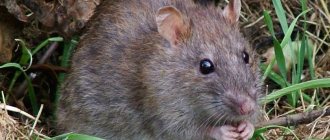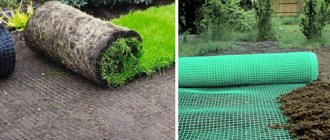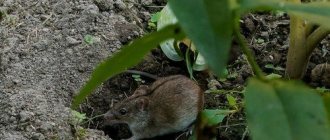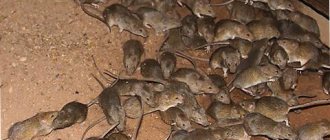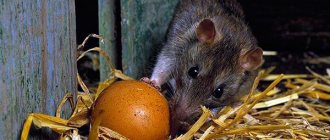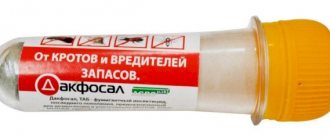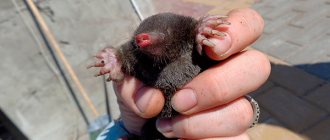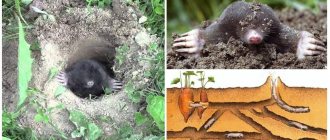Rats do a lot of harm to humans. They destroy and spoil food supplies; they gnaw walls, floors, roofs; cause electrical wiring to become unusable, which may cause a fire. However, this is not even the biggest danger of rats.
Rats are carriers of more than 20 serious diseases, including those that can lead to human death. For this reason, extermination of rodents must begin immediately after their appearance.
Various methods are used to control rats:
- mechanical;
- biological;
- chemical;
- repellent;
- folk remedies.
Description and features of the earth rat
The ground (water) rat or water vole is a rodent belonging to the hamster family. Main characteristics:
- body size from 11 to 26 cm;
- weight from 120 to 380 g;
- the length of the tail is from half to two thirds of the length of the body.
At first glance, the earth rat looks like an ordinary one, but has a more rounded body, a shortened blunt muzzle, and shorter legs. The eyes and ears of an earthen rat are smaller than those of a normal rat, and its incisors are brownish-yellow. The fur is soft, thick, and the color ranges from dark brown to almost black.
Earth rat
Lifestyle
Ground rats spend most of their lives underground. At a depth of 10 to 40 cm, they dig a complex and fairly extensive system of passages that connect a nest made of twigs, sticks, grass, pieces of paper and fabric, several pantries for storing supplies and numerous exits to the surface.
These animals are mainly nocturnal. With the onset of darkness, rodents come to the surface and go in search of food, trying not to stray far from the entrance to the hole. During the day they rest in the nest or dig new tunnels.
Digging holes in the ground, rodents destroy everything in their path - the roots of herbaceous plants, trees and shrubs, root crops, and bulbs suffer from the teeth of pests. Earth rats swim well and climb trees deftly. They don't hibernate. They spend the cold season underground, closing the burrow entrances and feeding on reserves.
Diet
Ground rats that have settled on a personal plot pose a serious threat to all plants. This is explained by the fact that the rodent eats plant foods, and its diet is very varied. Water voles gnaw at the roots of garden plants, eat root vegetables, eat the bark of trees and shrubs, and gnaw on succulent stems. In addition, earth rats can hunt insects, small rodents, fish and crayfish, climb into bird nests, eat eggs and even attack chicks.
Living next to humans, rats eat food waste, as well as supplies of vegetables and grains stored in sheds and cellars.
Habitat
The habitat of ground rats is quite wide. Rodents are found throughout almost the entire territory of Russia with the exception of the Far North, in Belarus, Ukraine, the Baltic countries, Kazakhstan, the northern regions of Mongolia, northwest China, and the countries of Central and Eastern Europe.
Most often, ground rats live along the banks of bodies of water (rivers, ponds and lakes), but often move to fields and meadows, to vegetable gardens and orchards with fruit trees. Most often, such movements are caused by high waters and floods, early frosts or lack of food.
How can you tell if there are mice in your dacha?
The following signs may indicate that new residents have appeared in the house or nearby:
- The presence of minks near the walls of the house and outbuildings.
- Characteristic holes in the insulation or cladding of a building.
- Traces or already clearly visible paths near the wall.
- Bags or boxes containing various cereals or other products are damaged.
- Blankets, furniture, various textiles, including clothes, were damaged.
- Electrical wiring or even some pipes may be chewed.
- The harvest, which is already in the basement, has been gnawed.
- You can find droppings that have a specific smell both outside and inside the house.
- At night a characteristic squeak and rustling noise is heard.
- Fruits are spoiled, both fruits and vegetables, young plants, especially tulip and daffodil bulbs.
- Tree bark has been chewed.
- There is a regular shortage of eggs in the chicken coop.
- Domestic cats and dogs show anxiety and often sniff as if looking for someone.
If at least one of the listed points occurs, you need to urgently think about it and take effective measures to destroy or expel the mice. In this case, there is no time for thought and doubt. The fact is that rodents that enter a person’s house belong to a group of mice that always live next to people and are attached to them. Animals quickly adapt to any conditions and can easily tolerate heat, cold, heavy rainfall or prolonged lack of food.
Why do earth rats appear?
There are several main reasons why there are rats in a summer cottage. The first is the abundance of food, which allows rodents not only to eat plenty, but also to stock up for the winter. The second reason for the appearance of earth rats in the countryside is the large number of places suitable for constructing a convenient and safe shelter.
Rat "gang"
Rodents make nests in cellars and basements, sheds and outbuildings, and also actively inhabit tunnels previously dug by moles and shrews.
Burnt remains
Another class of substances that rats cannot tolerate are burnt or burned remains of certain substances:
- Burnt feathers or down. You can burn any feather, but duck down has the most repulsive smell. The burnt remains are mixed with starch and scattered around the house.
- Burnt rubber. Rats are afraid of this smell and immediately leave the area where it is smelled. Pieces of rubber are placed in a metal container, poured over with flammable liquid and allowed to burn. The burned parts are laid out around the house. The container retains the smell well, so it is also used for repelling.
But the most effective protection is provided by burnt rat fur, which causes its relatives to feel a strong sense of danger. This method has been used by people since ancient times. To do this, the skin must first be removed and then set on fire. The resulting residue will be the most effective rat repeller.
Why are they dangerous?
Earth rats cause serious damage to agricultural plants. By digging underground passages, rodents damage the root system of plants, which leads to their drying out and death, and in the case of fruit trees and shrubs, to loss of harvest. In addition, rodents gnaw bark from trees, causing serious harm to them.
Earth rats gnaw large root crops, and carry small ones into holes for storage. They love to feast on melons and melons. Due to damage caused by the sharp teeth of rodents, melons and watermelons quickly become unusable.
If there is not enough food in the garden, rats enter where vegetables and grain are stored and eat the supplies. They can also get into houses where they feed on food. The appearance of rats is dangerous for people, since animals carry pathogens of severe infectious diseases (plague, leptospirosis, tularemia).
What danger do mice pose?
Mice are a real problem. Animals not only damage walls, furniture and clothing, they eat or infect food, “shit” everywhere, carry a “mouse” smell and breed in huge numbers. It would seem, what do tiny furballs with beady eyes and constantly moving antennae have in common with big problems or diseases? In fact, everything is very serious, because mice:
- Spoil or destroy food. And if fur, excrement or pieces of dead skin get into the latter, then there is a very high probability that people will experience food poisoning, allergic reactions, and exacerbations of diseases (for example, the respiratory tract).
- They can bring fleas into the house that carry dangerous infections to humans.
- They carry viruses and pathogenic bacteria that can cause dangerous diseases such as plague, typhoid, cholera, as well as various serious poisonings.
- They can cause a fire because they chew through wiring in places that, at first glance, seem completely inaccessible.
- They leave an unpleasant, specific, difficult-to-remove odor in the house.
Getting rid of earth rats
The sooner the fight against voles on the site is started, the faster the pests will be dealt with, which means the greater the chance of saving the plants.
You can get rid of earth rats in the garden in the following ways:
- pesticide;
- traps;
- scaring away
You can use natural enemies of rodents, as well as use folk remedies.
Biological method of control
Cats or dogs can help people get rid of earth rats. It is best that these are adult animals that can hunt rodents, for example, rat-catching cats, dachshunds or terriers. A spoiled pet, of course, will not chase rats, but its presence can also be useful - there is a possibility that the rodents will be scared away by the smell of a cat or dog.
A cat or dog permanently living in the country will help both remove rodents and protect the area from their return.
Repellent
When deciding how to drive a rat out of the area, you should pay attention to special devices - ultrasonic repellers. They generate ultrasonic waves that people cannot hear, but they have a negative effect on rodents, causing anxiety and fear. The devices are easy to use, safe for people, but have several disadvantages.
- Firstly, they act not only on rodents, but also on pets.
- Secondly, the rats gradually get used to it and stop paying attention to the signals.
- Thirdly, according to many users, the effectiveness of such devices is greatly exaggerated.
Repeller
Plants
The most environmentally friendly way to drive rats out of your area is to plant plants whose smell rodents cannot stand. Planting black elderberry will be the most effective. Not only does its smell repel rats and mice, but the roots of the plant also release cyanide into the soil, which has a detrimental effect on rodents. In addition to elderberry, rats are repelled by the aroma of mint, tansy, and wormwood.
Destruction by toxic substances
Some summer residents prefer to use radical measures to combat earth rats - poisons. There are a large number of chemicals that can be used to kill mice, rats, and moles.
We must remember that using toxic substances to poison rodents must be done with great caution. It is necessary to observe safety precautions and act strictly according to the instructions.
Even with the help of poison, getting rid of rats will not be so easy, since rodents quickly adapt to the poison. To be sure to kill voles, it is necessary to change the drug from time to time.
Using traps
Traps are one of the most popular means of rodent control. Models such as:
- adhesive;
- trap;
- electric.
The main problem is where to put the caught animals.
Flooding of holes
Ground rats are excellent swimmers. But they will not live in wet soil and flooded burrows. So if you fill the rat tunnels by running water under pressure through a hose, then there will be no rodents left in your summer cottage.
Smoking
Another way to get rid of earth rats in the garden is to place smoldering scraps of fur or skins in all discovered exits from holes. Rodents cannot stand the smell of burning fur and will try to leave their home as quickly as possible.
Folk remedies
Many people prefer to fight rats using folk remedies. The most popular method is to place rags soaked in strong-smelling substances - gasoline, kerosene, grease - at the entrances to burrows. Homemade traps are also used.
Essential oil
If suitable plants are not at hand, then the appropriate essential oil can be used instead. Peppermint essential oil is considered the most effective against rats. It is added to water and sprayed on the room or wiped on floors and other surfaces.
To obtain a stronger product, add alcohol at the rate of 10 ml per 300 ml of water and 15 drops of aroma oil. The resulting mixture is used to treat cracks, baseboards, floors and other places.
How to distinguish rat holes from mole holes?
You can detect the presence of earth rats by the presence of holes in the garden. But besides water voles, burrows can also belong to other animals. Most often, you can find passages in the ground made by moles. Understanding who exactly is digging the ground is not so difficult. At the exit from the wormhole, the earth lies in a triangular mound, and near the exit from the rat’s home there is a flat mound. In addition, unlike a mole, a vole disguises its exit with leaves, twigs and debris.
Rat hole
Preventive measures
The following preventive measures will help prevent the appearance of earth rats on the site:
- timely weeding, removal of plant debris (fallen leaves, rotten fruits, dead wood);
- keeping the area clean (there should be no garbage or food waste);
- deep digging of beds and row spacing in the fall after harvesting;
- regular inspection of the area for the presence of burrows;
- the compost pit should be equipped in the far corner of the site, away from the beds.
When harvesting, it is very important to check that there are no root crops left in the ground, and that there are no remains of herbs and vegetables in the beds. A cat or dog periodically walking around the area will also help protect against rodents.

